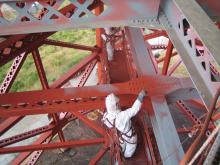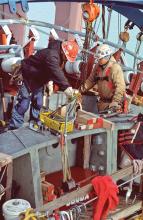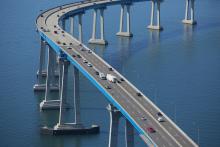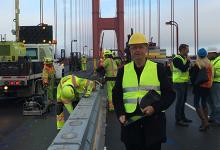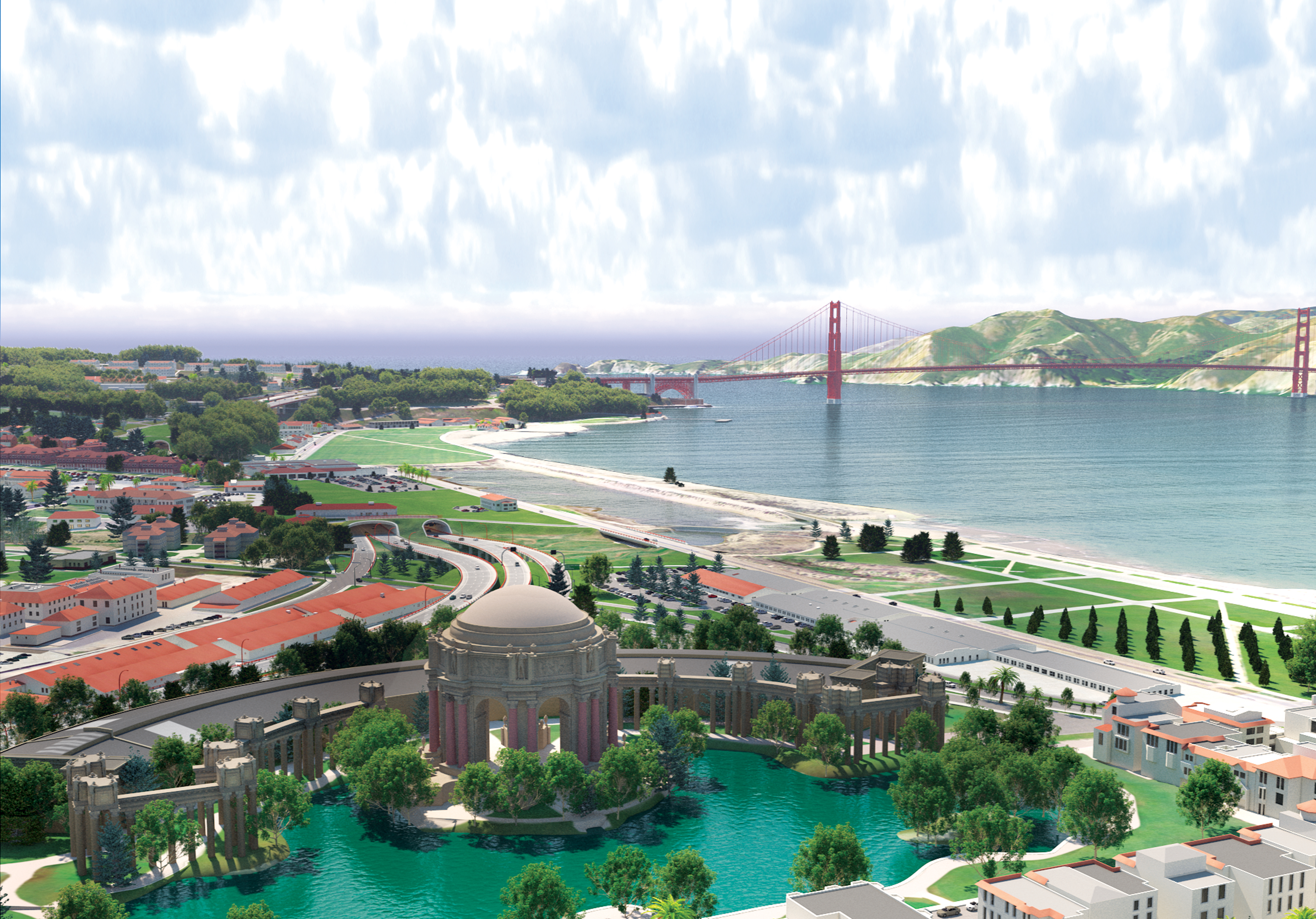
Work on the Presidio Parkway, a new breathtaking and eco-friendly southern approach road to San Francisco’s Golden Gate Bridge, has entered its crucial second and final phase. As Guy Woodford reports, the vital US$1 billion project has overcome legal as well as environmental challenges to stay on course for its expected 2016 completion
Just after 9pm on Friday April 27, 2012 a large public crowd looked on excitedly as a fleet of more than 40 R&L Brosamer and Ferma Corporation deployed hydraulic demolition hammers began crashing into Doyle Drive: the 1936-built highway which had given millions of drivers a southern access to San Francisco’s Golden Gate Bridge. The action-packed“At 7.59pm there was a very active six-lane highway. Then between 8 and 9pm the
The Presidio Parkway project is a partnership involving SFCTA, Caltrans, The Presidio Trust,
The two-phase construction element of the project to transform the structurally and seismically deficient Doyle Drive into the 2.41km Presidio Parkway, a highway fitting snugly into the natural contours of San Francisco’s Presidio area and the Golden Gate National Recreation Area, one of America’s largest urban parks, began in late 2009. The first phase, completed in 2012, included the construction of the Ruckman Bridge on Highway 1, the southbound High Viaduct, the first of four new tunnels and a temporary bypass. The new temporary bypass, which moved traffic permanently off Doyle Drive, achieved crucial seismic safety for what is a heavily used corridor.
A particular challenge during the Phase One construction of the southbound battery tunnel was its location within the heavily restricted footprint between the San Francisco National Cemetery and the existing Doyle Drive. One retaining wall was just 13.97cms from the cemetery. The project team are said to have worked closely with the Department of Veterans Affairs to ensure protection of the cemetery land and historical resources.
The second phase of Presidio Parkway is seeing the construction of the northbound High Viaduct, the three remaining tunnels, new connections to the Presidio, final landscaping, and the removal of the temporary bypass featuring a movable median barrier from
Bud Tolp, deputy project manager for design-builder
“We are in a very high seismic area and are utilising cement deep soil mixing (CDSM) as part of the foundation treatments. We are also using a combination of the CDSM and conventional drill shafts,” explains Tolp.
“The new Parkway structures have to be able to withstand the upper level seismic event and not collapse [the under construction Presidio Parkway], or sustain any structural failure.”
Of the variations in geology within the Presidio Parkway site, Tolp says: “It goes from the western end of the job where you only have maybe 15 to 40ft of overburdens, and you hit pretty competent Franciscan formation rock, or very dense Colma sand that is almost as hard as a rock; to the east end of the job, where the soils are poor quality and primarily deposits sitting on top of Bay mud.”
Tolp says the 1906 earthquake in San Francisco – which claimed the lives of around 3,000 people and destroyed more than three-quarters of San Francisco - is still contributing more than 100 years later to the complex geology on the Presidio Parkway route.
“Even in Phase One CDSM was considered by Caltrans as a potential foundation solution for the poor soil conditions, and they performed a CDSM test program,” adds Tolp.
To Saage, the significance of the Presidio Parkway project is multi-faceted: “There’s the amount of time it has taken to reach consensus of what needs to be done, the extraordinary design the project represents, and the setting.
“Doyle Drive was designed back in the 1930s. It had no shoulders and, importantly, it had no separation from oncoming traffic. Interestingly enough, the accident rate in its history had not been that bad. Our theory has been that people were so terrified driving on it, they paid very close attention! Unfortunately, when accidents do happen they tend to be both spectacular and deadly. Over the years we have had a spate of those [kinds of accident] which has been a real cause of concern.
Equally of concern, according to Saage, has been the structural condition of the route. “It was built at a time when we knew even less than we do now of seismic engineering. We had a major seismic event in the Bay Area in 1989, and it was more luck than anything else that Doyle Drive survived. There was damage but it was relatively superficial. It dodged the bullet in a sense. It caused the California Department of Transportation (Caltrans) and others to look at it more carefully, and they realised Doyle Drive was very vulnerable. Being a peninsula, San Francisco is really isolated. It depends utterly on the Golden Gate Bridge and the Oakland Bay Bridge for its lifeblood, for commerce.”
Saage says that in the early 1990s SFCTA did a failure analysis of what would happen if Doyle Drive fell down. “It was shocking to realise that it would literally put the entire Bay Area into transportation gridlock,” he exclaims. “It wouldn’t just be inconvenience for commuters: we’re talking about people not being able to get gasoline deliveries; not being able to get food delivered. It would be a horrendous hit to the economy of the area.”
Recognising something needed to be done, Saage says Caltrans and SFCTA agreed to work together to rebuild Doyle Drive.
“It had to be done in the San Francisco Way; it [a new highway] had to sit within the national park; and it had to be aesthetically pleasing.
“In typical San Franciscan fashion a Citizens’ Group was formed and Michael Painter, a landscape architect, offered services to this group, pro bono. They met over several years and came up with this design concept and published a report called ‘A Parkway for the Park’. We received the report in 1993 and thought it had some interesting ideas in it and we began a planning process in partnership with Caltrans.”
As he talks with great enthusiasm about the early days of the Presidio Parkway project over a coffee at SFCTA’s Downtown San Francisco HQ, the rich historical significance of the old Doyle Drive route is something Saage is equally enthused about.
“Doyle Drive was designed and constructed a year earlier than the Golden Gate Bridge. At that time, the Presidio where this project sits was an active US Army base. The Bridge District had to get permission from the War Department to build it. The Army was primarily concerned about security, about not having any access to the base. So Doyle Drive was built as an elevated route, giving no direct access to the base. Since then, the Army has gone and the Presidio became a national park in the early 1990s.”
Another significant obstacle the Presidio Parkway team has had to overcome is linked to the former Presidio Army base. Dave Pang, Caltrans construction manager, explains: “Most of the utilities were placed on the project site in the early 1930s. Changes to them have gone unrecorded, and unexpected utility relocation pushed the excavation timeline into one of the rainiest winters in recent San Francisco history, causing difficult conditions for excavation.”
Pang says that a shoring system using struts and tie backs was designed to support a 9.14m to 12.19m cut, minimise deflection, and still allow for the removal of nearly 76,500m³ of material. “To expedite tunnel construction, a custom travelling form system and high early-strength concrete mix designs were used,” adds Pang.
The Presidio Parkway project faced a legal challenge to the delivery of its second and final phase through California’s first major public-private partnership transport infrastructure initiative under State Senate Bill X2 (SB X2).
The state’s public-private partnership (P3) program started in 2009 when then governor Arnold Schwarzenegger signed SB 4 – allowing private companies to finance, build, operate, and maintain public roads under multiple-decade concession contracts.
After Phase 1 of Presidio Parkway was carried out under a traditional design-bid-build model, in January 2011 California’s Department of Transportation (Caltrans) and the San Francisco County Transportation Authority signed an agreement with Golden Link Concessionaire to finance, construct, maintain and operate the new elevated southern approach to the Golden Gate Bridge.
However, the Professional Engineers in California Government (PECG), a union of state engineers, claimed it would cost taxpayers more, and expose the public more to larger risks linked to private control over infrastructure investment. In November 2010, prior to the P3 Presidio Parkway signing agreement, PECG sued to stop the project, on the grounds that SB X2 didn’t authorise the use of availability payments to repay private investors in highway initiatives. A California state judge briefly halted the signing of the P3 agreement, but, in early 2011, lifted a temporary restraining order, allowing the P3 scheme to continue. In August 2011, California Supreme Court issued a final opinion rejecting all of PECG’s arguments.
Speaking about the legal challenge, Saage says: “Even during the litigation [November 2010-August 2011] we were able to continue some of the design work and some of the planning for Phase Two. It was not a complete loss, but it cost us a year.
“Had Doyle [Presidio Parkway] not been successful as a P3, it probably would not have augered well for P3 in the State. But with it being successful as a P3, it creates other opportunities.”
Barrier Systems making Presidio Parkway safer
Congestion on the old Doyle Drive had been historically managed by using plastic pylons as a centre divider that could be reconfigured to create a 3/2-2/3 traffic pattern. However, they were not thought to provide substantial protection between opposing lanes of traffic.
To improve the safety level on the temporary Presidio Parkway bypass, Caltrans installed a movable median barrier from Barrier Systems by Lindsay. A total of 2.1km of movable barrier is currently deployed on the five-lane bypass, and the barrier is shifted back and forth each day to create three lanes in the peak traffic direction in a 3/2-2/3 configuration.
Unlike the plastic pylons, the movable barrier provides positive barrier separation between opposing traffic lanes, preventing the possibility of a head-on collision.
This vital safety improvement proved crucial just four days after the movable barrier installation when a car smashed into the barrier and ricocheted off, without damaging any other vehicles.
3D Modelling for Presidio Parkway
Dave Pang, Caltrans construction manager, says coming up with a design for the tunnel systems substation for the new Presidio Parkway was a difficult task, as the lack of available space and the project’s architectural criteria meant it needed to be hidden within the structure. “The substation houses the extensive tunnel systems, including lighting, electrical, telecommunications, traffic monitoring, and fire suppression,” says Pang. “Building Information Modelling (BIM) processes and 3D modelling software including Revit, Civil 3D, Navisworks, and 3ds Max Design, all part of the Autodesk Infrastructure Design Suite, was used to help visualise and analyse options and determine the most space efficient and constructible solution. With the 3D modelling, project designers developed a system to reduce bends in rigid conduit and develop a more efficient, accessible substation.”
Tristan Randall, of Autodesk, who worked on Presidio Parkway between 2008-12 as the design coordinator for Parsons Brinckerhoff, part of the design joint venture with Arup, said the project has also seen the use of a new mobile platform: Autodesk BIM 360 Glue. “360 Glue is a cloud-based BIM management software that allows professionals to seamlessly access their project models and intelligent project data on their mobile device. This ensures that field staff has the most up-to-date information and can sync changes from the field back to the office,” explains Randall.
Bespoke oscillator for Presidio Parkway
To complement the Presidio Parkway’s picturesque setting, the project’s new high viaduct bridge was designed with fewer columns and wide spans to open views to the San Francisco Bay and surrounding area. To support the bridge columns, giant foundations are being set deep into the ground. In order to dig the 3.65m diameter foundations a custom-made 3.8m Leffer oscillator machine was purchased by Malcolm Drilling.
The 80tonne oscillator was used to twist giant, 3.65m wide steel casings, some to a depth of over 60m, through unstable ground conditions. These permanent casings form large foundation piles and are filled with reinforced concrete to create the seismically safe bridge foundations.
The machine’s innovative oscillating motion eliminates the induction of vibration into the surrounding ground, minimising impact to nearby historic and natural resources, while also greatly reducing noise associated with more traditional, brute force pile driving.
Bored piles of this diameter and depth require a different perspective and approach than the ‘normal’ foundation pile due to size and weight of all the materials as well as required installation equipment. They also require special considerations of the borehole wall stability, both in caving soil and potentially caving rock. Malcolm Drilling says the new oscillator machine, thought to be the largest ever used worldwide, has proven that it can effectively advance steel casings to an extreme 60m plus depth using a vibration free installation method.

